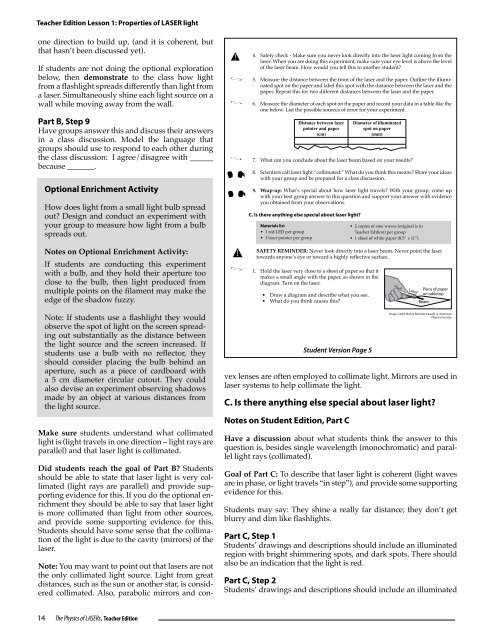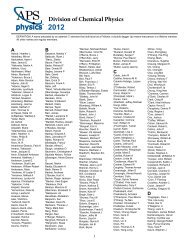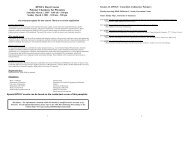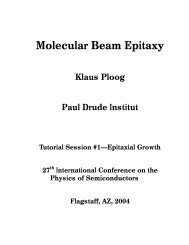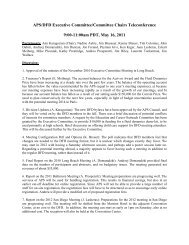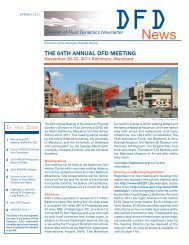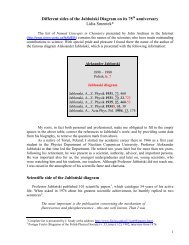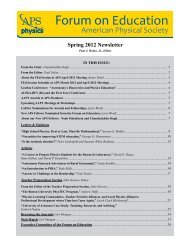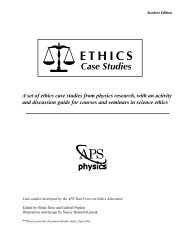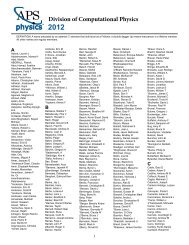The Physics of LASERs - American Physical Society
The Physics of LASERs - American Physical Society
The Physics of LASERs - American Physical Society
Create successful ePaper yourself
Turn your PDF publications into a flip-book with our unique Google optimized e-Paper software.
Teacher Edition Lesson 1: Properties <strong>of</strong> LASER light<br />
one direction to build up, (and it is coherent, but<br />
that hasn’t been discussed yet).<br />
If students are not doing the optional exploration<br />
below, then demonstrate to the class how light<br />
from a flashlight spreads differently than light from<br />
a laser. Simultaneously shine each light source on a<br />
wall while moving away from the wall.<br />
Part B, Step 9<br />
Have groups answer this and discuss their answers<br />
in a class discussion. Model the language that<br />
groups should use to respond to each other during<br />
the class discussion: I agree/disagree with ______<br />
because _______.<br />
Make sure students understand what collimated<br />
light is (light travels in one direction – light rays are<br />
parallel) and that laser light is collimated.<br />
Did students reach the goal <strong>of</strong> Part B? Students<br />
should be able to state that laser light is very collimated<br />
(light rays are parallel) and provide supporting<br />
evidence for this. If you do the optional enrichment<br />
they should be able to say that laser light<br />
is more collimated than light from other sources,<br />
and provide some supporting evidence for this.<br />
Students should have some sense that the collimation<br />
<strong>of</strong> the light is due to the cavity (mirrors) <strong>of</strong> the<br />
laser.<br />
Note: You may want to point out that lasers are not<br />
the only collimated light source. Light from great<br />
distances, such as the sun or another star, is considered<br />
collimated. Also, parabolic mirrors and con-<br />
14<br />
Optional Enrichment Activity<br />
How does light from a small light bulb spread<br />
out? Design and conduct an experiment with<br />
your group to measure how light from a bulb<br />
spreads out.<br />
Notes on Optional Enrichment Activity:<br />
If students are conducting this experiment<br />
with a bulb, and they hold their aperture too<br />
close to the bulb, then light produced from<br />
multiple points on the filament may make the<br />
edge <strong>of</strong> the shadow fuzzy.<br />
Note: If students use a flashlight they would<br />
observe the spot <strong>of</strong> light on the screen spreading<br />
out substantially as the distance between<br />
the light source and the screen increased. If<br />
students use a bulb with no reflector, they<br />
should consider placing the bulb behind an<br />
aperture, such as a piece <strong>of</strong> cardboard with<br />
a 5 cm diameter circular cutout. <strong>The</strong>y could<br />
also devise an experiment observing shadows<br />
made by an object at various distances from<br />
the light source.<br />
<strong>The</strong> <strong>Physics</strong> <strong>of</strong> <strong>LASERs</strong>, Teacher Edition<br />
!<br />
!<br />
vex lenses are <strong>of</strong>ten employed to collimate light. Mirrors are used in<br />
laser systems to help collimate the light.<br />
C. Is there anything else special about laser light?<br />
Notes on Student Edition, Part C<br />
Student Edition Lesson 1: Properties <strong>of</strong> LASER light<br />
4. Safety check - Make sure you never look directly into the laser light coming from the<br />
laser. When you are doing this experiment, make sure your eye level is above the level<br />
<strong>of</strong> the laser beam. How would you tell this to another student?<br />
5. Measure the distance between the front <strong>of</strong> the laser and the paper. Outline the illuminated<br />
spot on the paper and label this spot with the distance between the laser and the<br />
paper. Repeat this for two different distances between the laser and the paper.<br />
6. Measure the diameter <strong>of</strong> each spot on the paper and record your data in a table like the<br />
one below. List the possible sources <strong>of</strong> error for your experiment.<br />
Distance between laser<br />
pointer and paper<br />
(cm)<br />
Diameter <strong>of</strong> illuminated<br />
spot on paper<br />
(mm)<br />
7. What can you conclude about the laser beam based on your results?<br />
8. Scientists call laser light “collimated.” What do you think this means? Share your ideas<br />
with your group and be prepared for a class discussion.<br />
9. Wrap-up: What’s special about how laser light travels? With your group, come up<br />
with your best group answer to this question and support your answer with evidence<br />
you obtained from your observations.<br />
C. Is there anything else special about laser light?<br />
Materials list<br />
• 1 red LED per group<br />
• 1 laser pointer per group<br />
SAFETY REMINDER: Never look directly into a laser beam. Never point the laser<br />
towards anyone’s eye or toward a highly reflective surface.<br />
1. Hold the laser very close to a sheet <strong>of</strong> paper so that it<br />
makes a small angle with the paper, as shown in the<br />
diagram. Turn on the laser.<br />
• Draw a diagram and describe what you see.<br />
• What do you think causes this?<br />
Student Version Page 5<br />
• 2 copies <strong>of</strong> sine waves (original is in<br />
Teacher Edition) per group<br />
• 1 sheet <strong>of</strong> white paper (8.5” x 11”)<br />
Image credit: Nancy Bennett-Karasik, @ <strong>American</strong><br />
<strong>Physical</strong> <strong>Society</strong><br />
<strong>The</strong> <strong>Physics</strong> <strong>of</strong> <strong>LASERs</strong><br />
Have a discussion about what students think the answer to this<br />
question is, besides single wavelength (monochromatic) and parallel<br />
light rays (collimated).<br />
Goal <strong>of</strong> Part C: To describe that laser light is coherent (light waves<br />
are in phase, or light travels “in step”), and provide some supporting<br />
evidence for this.<br />
Students may say: <strong>The</strong>y shine a really far distance; they don’t get<br />
blurry and dim like flashlights.<br />
Part C, Step 1<br />
Students’ drawings and descriptions should include an illuminated<br />
region with bright shimmering spots, and dark spots. <strong>The</strong>re should<br />
also be an indication that the light is red.<br />
Part C, Step 2<br />
Students’ drawings and descriptions should include an illuminated<br />
5


